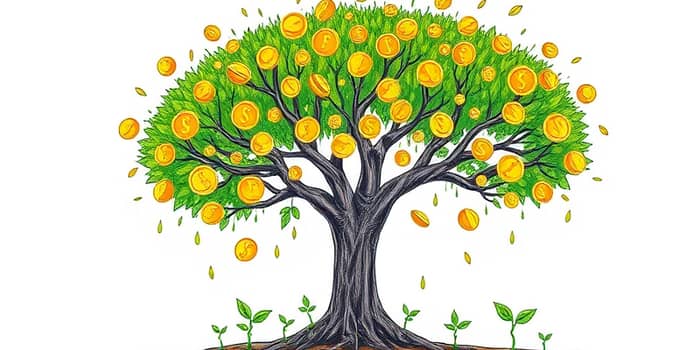
Dividend reinvestment transforms a passive income stream into a powerful catalyst for exponential portfolio growth. By choosing to automatically reinvest distributions back into the same securities, investors leverage the unique force of compounding. This article delves into Dividend Reinvestment Plans (DRIPs), outlines their benefits, explains the math behind compounding, and provides practical insights for creating lasting wealth.
A Dividend Reinvestment Plan enables shareholders to purchase new shares or fractional shares of a stock or fund without receiving dividends in cash. These plans are often available directly from public companies, through third-party transfer agents, or via most brokerages. Enrollment is usually straightforward, requiring an account link and plan registration.
On each dividend payment date, the plan automatically applies your dividend amount toward acquiring additional shares at the market price. Some company DRIPs even offer a price discount, typically between 1% and 5%, providing an extra incentive for participation.
Investors can often customize their DRIP settings on a per-security basis, enabling or disabling reinvestment for selected holdings. If you switch brokers, many firms facilitate transferring existing DRIP enrollments seamlessly, preserving your compounding schedule and share positions.
Be aware that some plans impose a minimum purchase requirement—commonly $10 to $100—and you should verify eligibility with your broker or the issuing company.
Compounding is the phenomenon where your reinvested dividends generate further earnings, creating a feedback loop of growth. Each round of dividends buys more shares, which in turn produces even larger dividends the next period. Over time, this dynamic growth can significantly outpace a strategy of taking dividends as cash.
Imagine investing $10,000 in a stock yielding 3% annually, with an average share price appreciation of 6% per year. After 30 years:
This illustration highlights how compound interest acts as an unforgiving multiplier over long periods, turning modest yields into substantial capital accumulation.
While most DRIPs boast low or zero transaction fees, taxation remains a key consideration. Dividends reinvested outside of tax-advantaged accounts—like IRAs or 401(k)s—are taxable as ordinary income in the year they are paid. Qualified dividends in the U.S. may qualify for lower rates (0%, 15%, or 20%), but state and local taxes can still apply.
When participating in a DRIP, record each reinvested dividend as a taxable event, tracking your cost basis for eventual sale. In taxable accounts, the benefit of compounding must be weighed against annual tax obligations, making retirement or education accounts an attractive shelter for DRIP strategies.
Maintaining accurate records is crucial for calculating gains and tax liabilities. Each reinvested dividend adjusts your cost basis. Mistakes in recordkeeping can lead to incorrect capital gains calculations, so consider using dedicated portfolio tracking tools or consult with a tax professional.
DRIPs inherently foster a disciplined investing mindset by removing emotional biases and timing pressures from dividend allocation decisions. Investors are less tempted to spend distributions or chase short-term market movements when dividends automatically reinvest.
Using a DRIP also enforces dollar-cost averaging over time, as purchases occur at varied price points, smoothing out volatility. This eliminates the need to decide when to redeploy each distribution and builds equity gradually.
Beyond financial metrics, DRIPs can have significant psychological benefits. By automating reinvestment, investors free themselves from constant monitoring and decision fatigue. This hands-off strategy nurtures confidence, reduces stress, and encourages a focus on long-term goals instead of daily market noise.
Although DRIPs are powerful for long-term investors, they are not universally right for everyone. Automatic share purchases occur at the prevailing market price, which can occasionally result in acquiring shares at high valuations. Overconcentration risk increases if an investor relies heavily on one security or sector.
Additionally, investors should be mindful of sector concentration risk. Reinvesting dividends into the same security increases exposure to that company’s industry. Periodically reviewing your overall portfolio diversification is essential to prevent undue risk if a sector faces downturns.
Beyond single-stock DRIPs, many mutual funds and ETFs provide optional dividend reinvestment features. These programs mimic DRIP principles by automatically purchasing additional fund units when distributions occur, often with no additional fees.
Internationally, similar offerings, such as Distribution Reinvestment Plans in Canada or Unit Purchase Plans in Europe, give global investors access to compounding benefits. Optional Cash Purchases available in several DRIPs allow periodic additional investments with low minimums, accelerating the compounding effect even further.
Some plans allow investors to schedule Optional Cash Purchases monthly, which can be particularly useful for those receiving regular paychecks. By aligning extra contributions with income inflows, participants reinforce a habit of saving and consistently channel a portion of their earnings into future growth.
Historical data demonstrates the profound impact of reinvestment. Since 1926, the S&P 500’s annualized total return—when including dividends reinvested—averaged around 10%, compared to roughly 6% if dividends were not reinvested. That difference compounds dramatically over decades.
For example, an investor who placed $20,000 into a diversified dividend-paying fund in 1990 and reinvested every distribution would likely see their position surpass $250,000 by 2020. A peer who took dividends in cash might accumulate only about $140,000 combined asset value and withdrawn distributions. This case underlines the transformative influence of compound interest when patiently harnessed.
Dividend reinvestment stands as a cornerstone of a long-term wealth-building strategy. By automatically redeploying distributions, investors harness the inherently powerful force of compounding growth, turning modest yields into sizable portfolios over decades.
Whether you are just starting your investment journey or optimizing an existing portfolio, enrolling in DRIPs and similar reinvestment options can help you maintain focus on the big picture, avoid emotional pitfalls, and steadily build financial resilience through consistent, disciplined investing.
Embrace dividend reinvestment not just as a tool, but as a philosophy that champions patience, resilience, and the remarkable potential of exponential growth. Over time, small, consistent actions yield extraordinary results.
References













